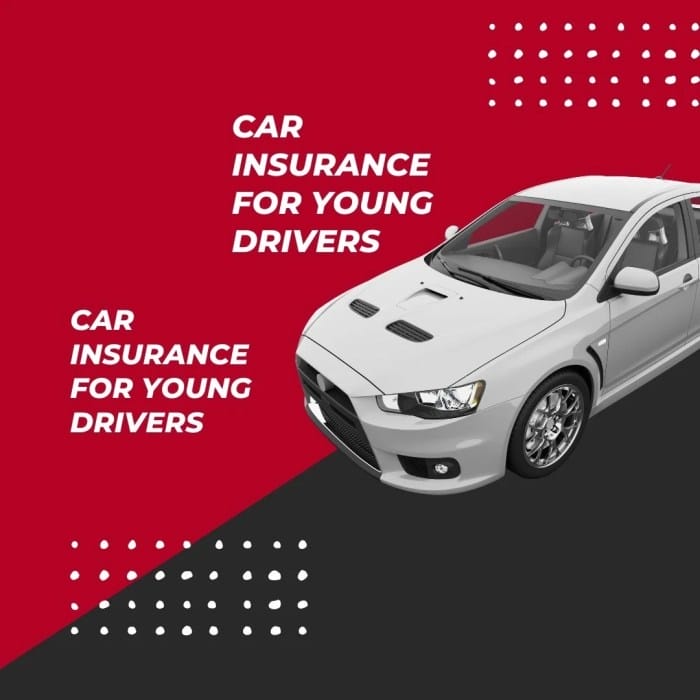Navigating the world of car insurance as a young driver can be daunting, especially when faced with often higher insurance rates. However, with careful planning and smart choices, it’s possible to find affordable coverage without compromising on quality. This comprehensive guide delves into the intricacies of car insurance for young drivers, offering practical tips and strategies to secure cheaper rates while maintaining essential protection.
From understanding the key factors influencing insurance costs to exploring innovative usage-based programs and non-owner car insurance options, this guide covers all aspects of car insurance for young drivers. Whether you’re a new driver just starting out or an experienced motorist looking to save money, this guide has something for everyone.
Identify Key Factors Influencing Insurance Costs for Young Drivers

Young drivers often face higher car insurance rates due to a combination of factors. Understanding these factors can help them make informed decisions to lower their insurance costs.
Age and Driving Experience:
- Age: Statistically, younger drivers are more likely to be involved in accidents, leading to higher insurance premiums.
- Driving Experience: The more driving experience a young driver has, the lower their insurance rate will generally be.
Driving History:
- Accidents: At-fault accidents can significantly increase insurance costs, especially for young drivers.
- Violations: Moving violations, such as speeding tickets or reckless driving, can also lead to higher insurance rates.
- Claims: Filing insurance claims, even for minor incidents, can negatively impact insurance premiums.
Location and Vehicle Type:
- Location: Insurance rates vary depending on the geographic area, with urban areas typically having higher rates due to increased traffic and accident risks.
- Vehicle Type: Sports cars, high-performance vehicles, and luxury cars generally have higher insurance premiums compared to more economical or family-friendly vehicles.
Research and Compare Insurance Quotes

Shopping around for insurance quotes is a crucial step in securing affordable car insurance as a young driver. This allows you to compare rates and coverage options from various providers to find the best deal that suits your needs and budget.
Obtaining Insurance Quotes
1. Identify Your Coverage Needs:
– Determine the level of coverage you require, including liability, collision, and comprehensive insurance.
2. Gather Personal Information:
– Prepare your driver’s license number, vehicle information, and any relevant claims history.
3. Compare Quotes Online:
– Utilize online comparison tools to obtain quotes from multiple insurance companies simultaneously.
4. Contact Local Insurance Agents:
– Reach out to local insurance agents who may offer personalized quotes and additional coverage options.
Negotiating Lower Rates and Discounts
1. Consider Bundling Policies:
– Explore bundling your car insurance with other policies, such as renters or homeowners insurance, for potential discounts.
2. Ask About Discounts:
– Inquire about discounts for good grades, defensive driving courses, or multiple vehicles insured under the same policy.
3. Negotiate Premiums:
– Engage in negotiations with insurance providers to secure lower premiums, especially if you have a clean driving record.
Maintain a Clean Driving Record
Maintaining a clean driving record is crucial for young drivers seeking affordable car insurance. Traffic violations and accidents can significantly increase insurance premiums. Avoiding common driving mistakes that lead to violations, such as speeding, reckless driving, and distracted driving, is essential.
Defensive Driving Courses
Taking defensive driving courses can improve driving skills, reduce the risk of accidents, and potentially lower insurance rates. These courses teach safe driving techniques, defensive maneuvers, and strategies for avoiding hazardous situations.
Choose a Vehicle with a Favorable Insurance Profile

When selecting a vehicle, young drivers should consider models with favorable insurance profiles to potentially secure lower premiums. Several factors influence insurance costs, including the vehicle’s safety features, theft rate, repair costs, and overall performance.
Vehicle Characteristics Impacting Insurance Rates
Insurance companies assess the risk associated with insuring a particular vehicle based on various characteristics. These factors include:
- Safety Features: Vehicles equipped with advanced safety features, such as airbags, anti-lock brakes, and electronic stability control, are generally considered safer and may qualify for lower insurance rates.
- Theft Rate: Vehicles with a high theft rate are more likely to be stolen, leading to higher insurance premiums. Conversely, vehicles with a low theft rate may attract lower insurance costs.
- Repair Costs: Vehicles with expensive parts and labor costs can result in higher insurance premiums. Insurers consider the cost of repairs when determining the overall risk associated with insuring a particular vehicle.
- Performance: High-performance vehicles with powerful engines and sporty designs are often associated with increased risk and may attract higher insurance premiums compared to more economical and practical vehicles.
Examples of Vehicles with Lower Insurance Rates
Certain vehicles are known for their favorable insurance profiles due to their safety features, low theft rates, and affordable repair costs. Examples of such vehicles include:
- Honda Civic: The Honda Civic is renowned for its reliability, fuel efficiency, and safety features. It consistently ranks among the vehicles with the lowest insurance rates for young drivers.
- Toyota Corolla: Similar to the Honda Civic, the Toyota Corolla is another reliable and fuel-efficient vehicle with a strong safety record. It is often considered a good choice for young drivers seeking affordable insurance.
- Mazda3: The Mazda3 is a compact car known for its sporty handling and stylish design. Despite its performance-oriented nature, it typically falls within the range of vehicles with lower insurance rates due to its safety features and reliability.
Tips for Finding Affordable Vehicles with Good Safety Ratings
Young drivers can employ several strategies to find affordable vehicles with good safety ratings:
- Research Vehicle Safety Ratings: Before making a purchase, research the safety ratings of different vehicles using resources such as the National Highway Traffic Safety Administration (NHTSA) and the Insurance Institute for Highway Safety (IIHS).
- Consider Used Vehicles: Used vehicles, especially those with low mileage and a clean accident history, can offer a more affordable option while still providing a high level of safety.
- Compare Insurance Quotes: Obtain insurance quotes from multiple insurance companies to compare rates and identify the most competitive options for the chosen vehicle.
Consider Usage-Based Insurance Programs

Usage-based insurance (UBI) programs offer young drivers an opportunity to potentially lower their car insurance premiums by monitoring their driving habits. These programs track metrics like mileage, driving behavior, and time of day driven, and adjust premiums accordingly.
Types of UBI Programs
There are two main types of UBI programs:
- Pay-as-you-drive (PAYD) programs: These programs charge a base rate plus a per-mile fee. The more you drive, the higher your premium will be.
- Mileage-based programs: These programs charge a flat rate per mile, regardless of how much you drive. This can be a good option for drivers who don’t put a lot of miles on their cars.
Benefits of UBI Programs for Young Drivers
UBI programs can benefit young drivers in several ways:
- Lower premiums: Young drivers are typically charged higher premiums because they are considered to be higher-risk drivers. However, UBI programs can help young drivers lower their premiums by tracking their driving habits and rewarding them for safe driving.
- Encourage safe driving: UBI programs can encourage young drivers to drive more safely by providing them with feedback on their driving habits. This can help them to develop good driving habits that will stay with them for life.
- Provide peace of mind: UBI programs can give young drivers peace of mind knowing that they are paying a fair price for their car insurance. They can also help young drivers to track their driving habits and identify areas where they can improve.
Insurance Companies Offering UBI Programs
Several insurance companies offer UBI programs, including:
- Progressive: Progressive offers a variety of UBI programs, including Snapshot, which tracks mileage and driving behavior, and MileSense, which charges a flat rate per mile.
- Allstate: Allstate offers a UBI program called Drivewise, which tracks mileage, driving behavior, and time of day driven.
- State Farm: State Farm offers a UBI program called Drive Safe & Save, which tracks mileage and driving behavior.
Each insurance company has its own UBI program with unique features and benefits. It’s important to compare the different programs to find the one that’s right for you.
Explore Discounts and Savings Opportunities

Exploring available discounts and savings opportunities can significantly reduce your car insurance premiums as a young driver. Insurance companies offer various discounts tailored to your circumstances and driving habits.
Common discounts for young drivers include:
- Good Student Discount: Maintain a good academic record to qualify for this discount, typically requiring a GPA of 3.0 or higher.
- Multi-Car Discount: Insuring multiple vehicles under the same policy often leads to savings.
- Loyalty Discount: Staying with the same insurance company for an extended period may result in loyalty discounts.
Bundling Insurance Policies
Bundling your auto insurance with other insurance policies, such as renters or homeowners insurance, can lead to substantial savings. Insurance companies often offer package discounts for multiple policies, recognizing the convenience and loyalty of customers who choose to consolidate their insurance needs.
Finding and Negotiating Additional Discounts
Actively seeking additional discounts and promotions can further reduce your insurance costs. Here are some tips:
- Ask about introductory discounts: Many insurance companies offer introductory discounts for new customers.
- Negotiate your premium: Contact your insurance company and inquire about potential discounts or lower rates. Politely expressing your interest in continuing with their services may lead to favorable outcomes.
- Consider usage-based insurance programs: These programs track your driving habits and offer discounts based on safe driving.
Raise Deductible to Lower Premiums

When purchasing car insurance, policyholders are presented with the option to choose a deductible. A deductible is a specific amount of money that the policyholder is responsible for paying out of pocket before the insurance company begins to cover the remaining costs of a covered claim.
Generally, choosing a higher deductible results in a lower insurance premium. This is because the insurance company assumes less risk by requiring the policyholder to pay a larger portion of the initial claim costs.
Understanding the Relationship between Deductibles and Premiums
The relationship between deductibles and premiums can be illustrated through an example. Consider a policyholder who is quoted an annual premium of $1,200 with a $500 deductible. If the policyholder increases their deductible to $1,000, their annual premium may decrease to $1,000. This is because the insurance company is assuming less risk by requiring the policyholder to pay the first $1,000 of any covered claim.
Pros and Cons of Choosing a Higher Deductible
Choosing a higher deductible to save on insurance costs has both advantages and disadvantages. Pros:
- Lower insurance premiums: By choosing a higher deductible, policyholders can potentially save money on their monthly or annual insurance premiums.
- Encourages responsible driving: A higher deductible can serve as a financial incentive for policyholders to drive more cautiously and avoid accidents, as they will be responsible for a larger portion of the repair costs if an accident occurs.
Cons:
- Higher out-of-pocket expenses: If an accident occurs, policyholders with a higher deductible will be responsible for paying a larger portion of the repair costs before the insurance company begins to cover the remaining balance.
- Potential for financial hardship: If an accident results in extensive damage, policyholders with a high deductible may face financial hardship if they are unable to cover the out-of-pocket expenses.
Ultimately, the decision of whether to choose a higher deductible to save on insurance costs is a personal one. Policyholders should carefully consider their financial situation, driving habits, and risk tolerance before making a decision.
Consider Non-Owner Car Insurance

Non-owner car insurance is a type of insurance coverage designed for individuals who don’t own a vehicle but occasionally drive other people’s cars. This type of insurance can provide valuable protection in situations where the driver does not have access to the vehicle owner’s insurance policy.
Non-owner car insurance policies typically include coverage for liability, property damage, and medical payments. Liability coverage protects the driver in case they cause an accident and are held legally responsible for damages to another person’s property or injuries. Property damage coverage helps pay for repairs or replacement of the vehicle being driven if it is damaged in an accident.
Medical payments coverage provides reimbursement for medical expenses incurred by the driver or passengers in the event of an accident.
Suitable Situations for Non-Owner Car Insurance
- Occasional Drivers: Individuals who only drive occasionally, such as those who rely on ride-sharing services or carpooling, may find non-owner car insurance to be a cost-effective option.
- Rental Car Coverage: Non-owner car insurance can provide coverage for rental cars, offering peace of mind and protection against potential accidents or damages.
- Business Use: Non-owner car insurance can provide coverage for employees who use their personal vehicles for business purposes, filling gaps in the company’s auto insurance policy.
Utilize Telematics Devices for Lower Rates

Telematics devices offer a modern approach to car insurance by monitoring driving behavior and utilizing this data to determine insurance rates. By installing these devices in their vehicles, young drivers can potentially qualify for lower insurance premiums.
There are various types of telematics devices available, each with its unique features and functionality. Some common types include:
Types of Telematics Devices
- GPS Tracking: Tracks the vehicle’s location, speed, and mileage.
- Accelerometer: Measures acceleration, braking, and cornering forces.
- Gyroscope: Detects changes in the vehicle’s orientation.
- Event Data Recorder (EDR): Captures data related to accidents, such as impact forces and airbag deployment.
These devices collect data continuously while the vehicle is in motion. This information is then transmitted to the insurance company, where it is analyzed to assess the driver’s risk profile. Safe driving habits, such as maintaining a consistent speed, avoiding harsh braking and acceleration, and obeying traffic laws, can lead to lower insurance rates.
Insurance Companies Offering Telematics Programs
Several insurance companies offer telematics programs, each with its own unique features and benefits. Some notable examples include:
- Progressive Snapshot: This program uses a plug-in device that collects data on driving habits. Drivers can earn discounts based on their driving score.
- Allstate Drivewise: This program utilizes a mobile app to track driving behavior. Drivers can receive personalized feedback and discounts for safe driving.
- State Farm Drive Safe & Save: This program offers a discount for drivers who maintain a good driving record and participate in the program.
When choosing a telematics program, it is essential to compare the features, costs, and discounts offered by different insurance companies to find the best option that suits your needs and driving habits.
Build a Positive Credit History
Young drivers often have limited credit histories, which can make it difficult to get affordable car insurance. However, by taking steps to build a positive credit history, young drivers can improve their chances of getting lower insurance rates.
Establish and Maintain a Good Credit History
To establish a good credit history, young drivers should:
- Get a credit card and use it responsibly. Make sure to pay your bills on time and in full each month.
- Apply for a loan, such as a student loan or a car loan. Repaying the loan on time and in full will help build your credit.
- Become an authorized user on a parent’s or guardian’s credit card. This will allow you to build credit without having to take out your own loan or credit card.
Improving Credit Scores Can Lead to Lower Insurance Premiums
Insurance companies use credit scores to assess risk. Drivers with higher credit scores are generally considered to be less risky and are therefore offered lower insurance rates. In some cases, drivers with good credit scores can save hundreds of dollars on their annual car insurance premiums.
Conclusion
In conclusion, securing cheaper car insurance as a young driver is achievable with a combination of informed decision-making, responsible driving behavior, and taking advantage of available discounts and programs. By following the tips Artikeld in this guide, young drivers can navigate the insurance landscape with confidence, ensuring they have the coverage they need without breaking the bank.
Frequently Asked Questions
Q: Why do young drivers typically pay higher insurance rates?
A: Young drivers are often considered higher risk due to their lack of experience and increased likelihood of accidents. This leads to higher insurance rates as insurance companies compensate for the perceived greater risk.
Q: How can young drivers improve their driving record and lower their insurance rates?
A: Maintaining a clean driving record is crucial for lowering insurance rates. Young drivers can achieve this by avoiding traffic violations, accidents, and claims. Additionally, taking defensive driving courses can demonstrate improved driving skills and lead to lower premiums.
Q: What are usage-based insurance (UBI) programs, and how can they benefit young drivers?
A: UBI programs monitor driving behavior through telematics devices installed in vehicles. This data is used to determine insurance rates based on actual driving habits. Young drivers with safe driving patterns may qualify for lower premiums under UBI programs.
Q: Can young drivers save money by bundling insurance policies?
A: Yes, bundling insurance policies, such as auto and renters insurance, can often lead to significant savings. Insurance companies frequently offer discounts for customers who purchase multiple policies from them.
Q: What is non-owner car insurance, and when might it be a suitable option for young drivers?
A: Non-owner car insurance provides coverage for drivers who don’t own a vehicle but may occasionally borrow or rent one. It can be a cost-effective option for young drivers who don’t have regular access to a car.



